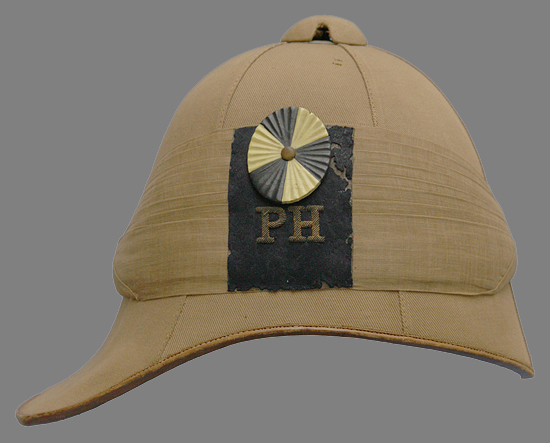
A colonial pattern helmet of Paget’s Horse showing one version of the helmet flash (Author’s collection)
Paget’s Horse was an elite unit whose four companies (51st, 52nd, 68th and 73rd) 1 made up the 19th Battalion Imperial Yeomanry. “They were public school-educated men recruited through advertisements in gentlemen’s clubs.
The battalion was raised by George [Thomas Cavendish] Paget, the son of a British general and a compulsive amateur soldier with a penchant for getting himself involved in any conflict that afforded the chance of action. He never seems to have been a regular officer but served in the Russo- Turkish War of 1877-8 and the Greco-Turkish War of 1897, as well as the Zulu War in 1879. Although aged 46 when the Boer War broke out, he went out to South Africa as second-in-command of his regiment and proved himself to be a man of some courage, being wounded twice. A portly figure who felt at home in the dining rooms and smoking rooms of Pall Mall, Paget recruited 500 officers and men from a tiny, hopelessly inadequate room at the Imperial Yeomanry Committee’s offices in Suffolk Street. However, it at least had the advantage of being only a short stroll from the clubs of which he was a member. Paget’s Horse wore a badge made up of the letters PH which provided a source of instant merriment for the wags on the streets of London, who suggested that it stood for ‘Piccadilly Heroes’ or more commonly for ‘Perfectly Harmless’.” 2
The 51st, 52nd and 68th companies departed on the troopship Tagus on the 16th March 1900 with the 73rd company following on the 31st March 1900 on the Delphic. 3 The battalion arrived in Cape Town, South Africa in April 1900 and was sent to Maitland Camp situated near Cape Town where it spent many weeks waiting for the arrival of its horses and was occupied in cleaning stables, fetching food and forage, striking tents etc. 4
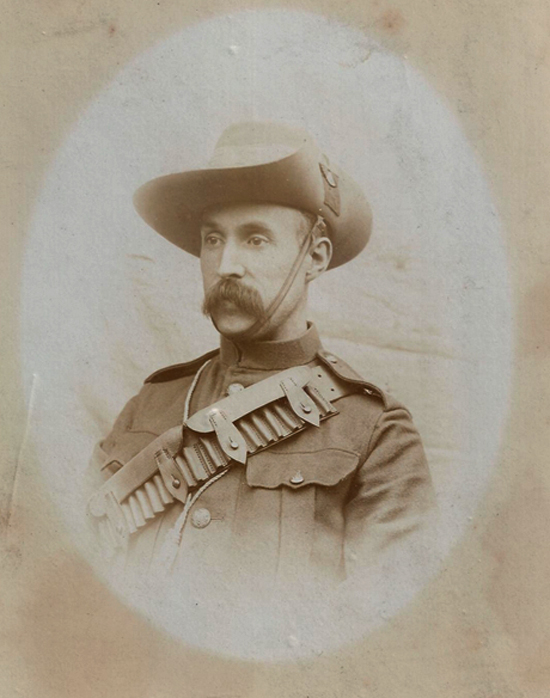
A splendid photograph of a trooper of Paget’s Horse wearing the slouch hat which became so popular during the 2nd Boer War. Note the flash does not have the embroidered initials of “PH” but does have the metal roundel (Photo courtesy of James Holt)
On the morning of the 30th May 1900 a small detachment of Paget’s Horse, led by Lt. J.G.B. Lethbridge, 52nd company, together with other Imperial Yeomanry units, Royal Canadian Artillery, and companies of the Duke of Edinburgh’s Own, was engaged in an action at Faber’s Put, in Griqualand West. Lt. Lethbridge was severely wounded with his left forearm being shattered and Trooper Mather was mentioned in despatches for assisting in bringing in the Lieutenant under “very heavy fire.” 5 Casualties were heavy with Rose-Innes stating “twenty-six killed and fifty-one wounded” of the entire force engaged.6
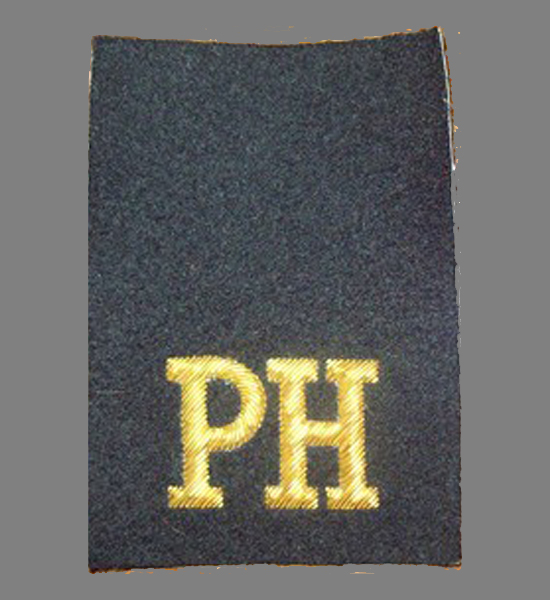
Another variation of the Paget’s Horse flash with no roundel and no evidence of one ever having been fitted (Photo courtesy of James Holt)
Paget’s Horse took part in several further actions, as well as convoy duty, including one “general engagement just outside Malmami where Sir Frederick Carrington and Lord Errol commanded. We galloped about from place to place the whole morning without firing a shot… We were not, I think, under actual fire altogether for more than half an hour, although the engagement itself lasted all day.” 7 Four squadrons of Paget’s Horse were present at this action. 8
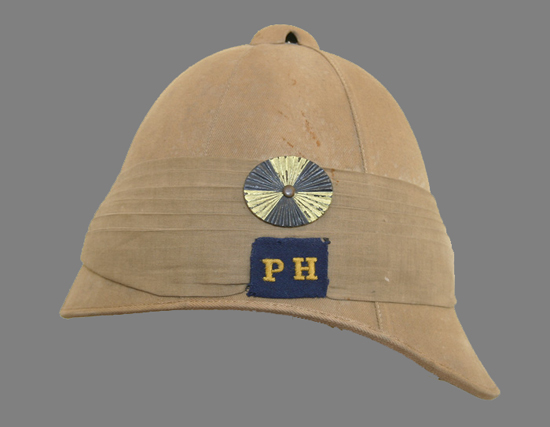
Another version of the helmet flash showing the roundel separate from the embroidered initials (Photo courtesy of Neville Constantine.)
There were many small engagements in which Paget’s Horse played a part, in conjunction with Colonial forces of New Zealand and Australia. The main area of activity was western Transvaal notably around Mafeking, Ottoshoop, Rustenburg, Zeerust, Lichtenburg, Schweizer-Reneke and the Elands River Staging Post.
“On Friday, the 26th day of July 1901, by command of His Most Gracious Majesty the King, we paraded at the ‘Horse Guards’ to receive our medals.” 9
Stuart Bates
Addendum: A reader has supplied a link to more information on Paget’s Horse see http://www.debtitsorted.co.uk/a-soldier-safely-home-from-the-war-this-time/

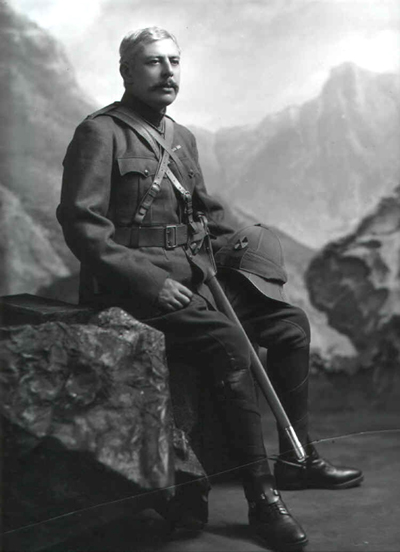
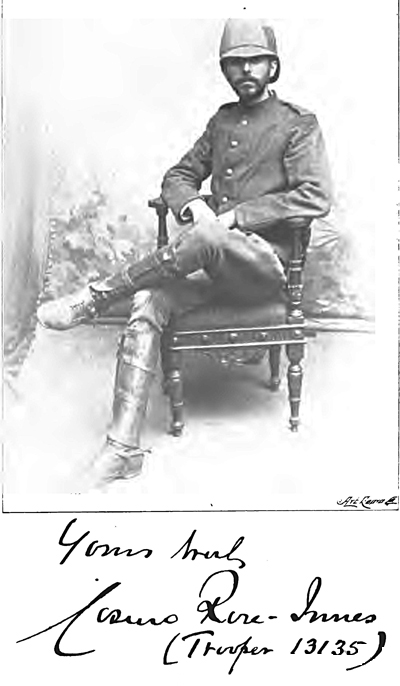
A very well written and interesting article.
A well researched, written and presented glimpse of Paget’s Horse. I can thoroughly recommend both books written by Stuart Bates & Peter Suciu.
Very nice article Stuart. Thanks for sharing.
Possibly the best article on Paget’s Horse I’ve read.Bravo.
My father was a member of Paget’s Horse for 1.5 yrs and received the King and Queen’s medals, was wounded at Zeerust and was at the Relief of Mafeking. He then served 1.5 yrs with the Bechuanaland Mounted Police. He later came to Australia, joining the AIF in 1914. Served on Gallipoli and on the Western Front. He was very badly wounded at both sectors. He was awarded the MC at the Battle of Lone Pine on Gallipoli and the DSO in France. He was 3 times Mentioned in Despatches. He finished the war as Lt Col J C M Traill DSO, MC . C O 5th Batt. AIF. He was on Active Service from day 1 of WW2 and died in 1942 as C O VDC Home Forces. I was just 10.
Hello Charles,
quite an impressive record. You must be rather proud of your father.
Regards,
Stuart
In researching the life of one of my wife’s ancestors Stanley Winther Caws (68th Coy Paget’s Horse) I came across this website and I agree with David Wanless’ comment that this is the best article I have discovered so far. Out of interest Stanley Winther was a 22 year old electrical engineer who went with the second contingent in January 1901. After returning home post-war he went to Canada in 1903 and did some prospecting and wore the colours of the North West Mounted Police (forerunner to the Royal Mounted Police) in addition to volunteering with the 19th Alberta Dragoons, no doubt putting to use what he learned in South Africa with PH. In 1905 he was a founder of the Lac Ste Anne Legion of Frontiersmen. In 1914 he returned to England with the first contingent of the Canadian Expeditionary Force but discharged his rank of sergeant with the 19th for the purposes of being appointed to a commission with the 10th Squadron Royal Flying Corps in early 1915. He died on September 21st the same year, shot dead at 10,000 by Max Immelmann ‘The Eagle of Lille’, his observer managed to regain partial control of the rapidly descending aircraft but it took a hard crash landing from which the observer crawled free whilst the wreckage and Stanley Winther Caws burned to a cinder.
Hello Damon,
thanks for the kudos and what a wonderful addition your reply makes. It is always rather pleasing when someone reads our articles but more so when they have a personal aspect to add.
Thanks,
Stuart
Pingback: A soldier safely residence from the war (this time) – Cover Letter
Hi, I believe my Grandfather ,Charles Sims – Bailey served with Paget’s Horse in the Boer War. Any record of him or advice on where I might trace his service.
Thanks
Hello David,
I googled “South African War Casualty Roll” and there are quite a few sites dealing with casualty rolls and records of the 2nd ABW.
Regards,
Stuart
David,
a search of the London/Edinburgh Gazette might be useful.
Stuart
I am currently doing research on General Koos De la Rey. Another source relating to Paget’s Horse is The Cossack Post. Journal of B Squadron, Paget’s Horse, De la Rey’s Farm. Lichtenburg, Transvaal. February to May, 1901. Junior Army and navy Stores, Ltd, York House, Regent Street, London, S.W. 1901
Hi Daniel,
I shall attempt to find The Cossack Post that you mention. Thanks for the info.
Stuart
Hi Stuart
I am currently involved with the development of a museum where we would want to display a Paget’s Horse Unifom – or helmet… Should you perhaps know of one that is for sale please 🙂
Thank you
Kind regards
Ps. The following novel (apparently partially based on the truth) may also be of interest to you:
Author: A Member of ‘Paget’s Horse’ and J P L
Title: The Life Impossible
Daniel
Hi Daniel,
there are only two Paget’s Horse helmets surviving and they are the two in the article. I suspect that you will be hard pressed indeed to find another.
Thanks for the tip on The Life Impossible.
Stuart
Pingback: A soldier safely home from the war (this time)
Pingback: Ach?-Podcast | 13 – Der Pfad des einäugigen Kriegers Sir Adrian de Wiart
My wife’s grandfather served with Paget’s Horse (see below):
Frank Courtenay-Hood was originally headed to the Civil Service but went into insurance. However the Boer War was going badly as our regular army tactics were stuck in the Napoleonic and Crimean wars so some bright spark suggested they raise Yeomanry Regiments from the “huntin’ shootin’ fishin” class to counter the very mobile mounted Boer commandoes. In 1900, aged 23, Frank joined one of the poshest – Paget’s Horse. Like everyone else, regardless of rank or position, Frank joined as a Trooper and supplied his own horses and tack. He joined 19th Paget’s Horse 73rd Company and was almost immediately promoted Corporal. One year later (1901) he was commissioned in the field to Lieutenant and, because of his technical abilities, appointed to command the Maxim Machine Guns Section. He was awarded the Queen’s South Africa Medal (Clasps: Cape Colony, Transvaal). Unusually he was asked to stay on after his initial term of service and remained with Paget’s until the end of the war receiving the King’s South Africa Medal (Clasps: South Africa 1901 & 1902). It was very unusual to have both medals (you can see them in his 1914 photo). I assume he remained in contact with the Yeomanry as a he was immediately promoted Captain on his volunteering at the outbreak of WW1. As a married man he did not have to volunteer. Obviously cavalry was a dodgy choice in WW1 so he joined his Kent County infantry regiment – my old regiment “The Buffs” (founded 1572!). He soon got bored training recruits in Dover and transferred to the York & Lancs as a Major to get into action. Later, as Lt-Col he commanded, at various times, the 12th, 13th and 14th Bns in most of the major battles. Towards the end of the war he was appointed CO of 5 KOSB in the final ghastly battles and the march to, and occupation of, Germany. After the war he resigned his commission on the grounds of “ill health” and returned to his insurance company heading up their international branch with frequent overseas visits (with his wife “Maimie”) in particular to Denmark and the USA. Although he had been gassed several times in WW1 he always returned to the trenches. My guess is he had “shell shock” (WW1 PTST) and it eventually caught up with him. He was finally sent to a sanatorium for British officers in San Remo where he died very young at 48.
Dear Richard,
thanks for adding a personal note to my article. It all adds to the sum. Yeomanry regiments did well in the wars in which they fought and you may be interested in the article that I wrote on the Royal Berkshire Yeomanry http://www.militarysunhelmets.com/2018/thomas-l-cpl-dcm-royal-berkshire-yeomanry#more-19439
Regards,
Stuart
P.S. Trooper Hood also appears as a member of B Sqn of Paget’s Horse in the book “Cossack Post”.
I believe my grandfather was a member of Paget’s Horse Company ( he was originally in the 51st Company Imperial Yeomanry).
His name was George Schwenn/Schwann. I was told he was wounded but have no further information. He would have arrived in Cape Town in April 1900. I have no more information. He did return to Australia and died in 1947. He suffered from extreme migraine headaches and blackouts throughout his life ,possibly as a result of injuries sustained during his time in South Africa. If anyone has any information that would help my research I would be most appreciative.
Maria, have been looking through a copy of casualties of the South African Field Force, and have not come across any Schwenn/Schwann. I was looking for a fellow called G.H. Anderson who seems to have survived unscathed. He arrived in South Africa in April 1900, so with the main part of the regiment. He returned to the UK in June 1901 and was commissioned into the 18th Hussars. all largely of no use to you, but perhaps it might give a clue.
G.H. Anderson, fought in the early part of WWI in France having walked some 500 miles out of German East Africa with askaris hot on his tail. he had been on a filming expedition with some American clients and fellow elephant hunter Jim Sutherland. He then ended up as an Intelligence Scout under General Northey in German East Africa. he also was in the Home Guard in WWII, and then ran a permanent camp in Nairobi, Kenya handling Army welfare issues.
Hi Stuart,
I am secretary to Fermanagh Genealogy Centre and we are putting on an exhibition in Enniskillen Castle Museum on a distinguished Fermanagh family called Loftus Tottenham. I noticed that Edward Loftus Tottenham (1868-1947) signed his attestation papers on 24th January 1901 and has listed Paget’s Horse, Imperial Yeomanry as his regiment. His serial number is 20407.
He lived in Richmond, Surrey at the time. I know he was 33 years of age when he enlisted and was certainly not a career soldier, re-joining the civil service after the Boer War in which he served. He survived and returned to Fermanagh with his family who still live there.
One of his brothers, Ponsonby John Loftus Tottenham served in the South Staffordshire Regiment, also in the Boer War. Any further information would be very much appreciated.
Yours Mervyn Hall.
I have a QSA medal to Private E.A. Ponder who was with the 51st and 73rd squadron’s of the Imperial Yeomanry and I would like to find out in which battles/engagements these squadrons these squadrons were involved
Allan,
I do not do research projects anymore because of helath reasons. However, did find this https://www.angloboerwar.com/unit-information/imperial-yeomanry-by-company/2361-51st-company-12th-battalion
You should not have too much trouble tracking the information you want.
Stuart
Looking for info on John Lauder who married Margaret Elizabeth Irvine.
A letter from Margaret’s brother William John Irvine written 1956 said John Lauder had died in South Africa. Margaret was born 1872, so John Lauder was probably born around that time.